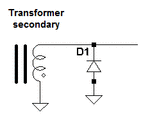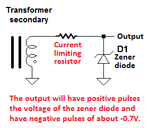neazoi
Advanced Member level 6
Hi,
The attached image shows a pulsed transformer secondary.
The transformer can output both positive and negative pulses.
I have used a silicon diode to cut off the negative pulses.
What I need is to cut off the negative pulses, but also regulate the positive pulses using a zenner.
Can both jobs be done using a single zener and how should the zener be connected in the circuit?
The attached image shows a pulsed transformer secondary.
The transformer can output both positive and negative pulses.
I have used a silicon diode to cut off the negative pulses.
What I need is to cut off the negative pulses, but also regulate the positive pulses using a zenner.
Can both jobs be done using a single zener and how should the zener be connected in the circuit?

